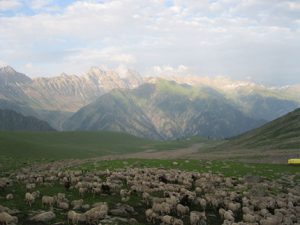Be it the famed Pashmina shawls or the meat Kashmiris so love, the grasslands of Ladakh and the alpine pastures of the Kashmir Valley have long been a livelihood resource in India’s Jammu and Kashmir state. But the vital livestock-livelihood link, a way of life for centuries in the Himalayan region, could come undone as natural processes and human activity combine to threaten the pasture lands as never before.

The pastoral lands of Ladakh, a cold desert, and the Kashmir Valley – the two regions along with Jammu in the plains comprise the border state of Jammu and Kashmir – have played host to a variety of livestock and been a critical driver of the local economy since time immemorial.
But these lands, say experts, are now under threat from overgrazing, encroachments, denudation, weeds, sandstorms, soil erosion, landslides and snow avalanches. The armed conflict in the region – the centre of the conflict between India and Pakistan both of which claim parts of the state – and mismanagement have contributed to the slide.
“Our pastures are in danger due to a number of natural processes and human activities. If immediate steps are not taken, they will get damaged beyond redemption,” Rehman Shah, a senior scientist with the state’s department of ecology and environment, told thethirdpole.net.
“I have conducted a comprehensive study of pastures in our part of Himalayas and found that people were unaware about proper utilization of pastures.”
Pastures, he added, were being utilized way beyond their carrying capacity, resulting in their deterioration.

According to Shah, the pattern of overgrazing and anthropogenic pressure was similar in Ladakh and Kashmir but the destruction due to natural forces was quite different in the regions with varying topography.
In Kashmir, he said, pastures were being degraded by soil erosion while wind erosion and vegetal degradation due to droughts were taking their toll in Ladakh.
Other factors too have wrought damage.
Mohammad Asif, a researcher with the sheep husbandry department in the Ladakh capital Leh, said that off-road driving was one reason for degradation of low-lying pastures.

The armed conflict has played a role too.
The dispute over Kashmir has led to two wars between India and Pakistan in 1947 and 1965 and a third armed conflict in Kargil in 1999. The insurgent movement, which escalated in the late 1980s, added to the region becoming one of the most volatile in the world. And the fragile ecological-livelihood-livestock balance has been a casualty.
The Indian government has responded with a huge deployment of troops in various areas of the beautiful Himalayan region with many army camps, mostly in forest areas.
Many of these army camps have been established in the idyllic meadows of Kashmir, including Sonamarg, Gulmarg, Tosa Maidan, Chur Khun, Badami Bagh, Doda Pathri and Banghas Valley.
The mere deployment of the army in so many alpine pastures means that they are cut off for livestock grazing. Farmers and others find it impossible to take their cattle to these pastures.
In Tosa Maidan, a lush green alpine pasture about 110 km west of Jammu and Kashmir’s summer capital Srinagar, for instance, villagers are campaigning to get their land back. They have complained that military exercises have led to heavy casualties in terms of people, including hundreds of villagers being maimed, as well as livestock.
The vast meadow measuring over 375 acres has been taken on lease by the Indian Army from the state government for military exercises. The lease ends in April, and people in the more than 30 villages around Tosa Maidan have begun a massive campaign against it being renewed – the army has asked for a fresh 20 year lease.
Infrastructure development is also taking its toll. In October this year, the forest department revealed that more than 875 hectares of forest land had been used for road construction in the past few years. Apart from this, the increasing number of tourists to places like Gulmarg and Sonamarg has also meant infrastructure (in concrete) overtaking the grassy expanses.

All of this has hit many thousands of people in various ways.
Pastures in Kashmir and Ladakh play host to different types of livestock. These include the pashmina goat, found in the harsh climate of Ladakh, which produces the finest pashmina wool used for making shawls, prized for their texture and warmth.
A pashmina shawl can cost anywhere between $200-600. According to government figures, exports of pashmina products fetched $160 million in 2011-12.
While Ladakh produces the highly-priced pashmina, the Kashmir region helps meet the huge demand for meat. Meat figures prominently in Kashmiri cuisine. Figures from the animal husbandry department indicate that Kashmiris consume 51,000 tonnes of mutton annually, making the meat industry a multimillion dollar one.
Winters only exacerbate the problem with grass becoming scarcer.
“When the temperature starts decreasing from September itself, the pastoralists start descending down to the winter pastures. So the winter pastures feel the load way too early,” Mohammad Sharief, a sheep husbandry officer in Ladakh, told thethirdpole.net.
“By January, the vegetation in the winter pastures gets entirely exhausted and the grass doesn’t grow afresh. Due to this, we need to store a good quantity of fodder for the livestock; otherwise the animals will perish as happened twice in the last five years.”

In order to deal with the challenge, Sharief said his department is planning to develop pastures by artificial methods.
“We are thinking of irrigating pastures by sprinkle irrigation with the funds meant for pasture development. We know it is not easy considering the huge amount of money it can take to cover the vast area of the degraded pastures, but we are attempting it nonetheless.”
In Kashmir, experts say, the government should determine the carrying capacity of the pastures. Also, fresh pastures should be made easily accessible to farmers and their livestock.
“To ensure the sustainability of the pastures, we need to grade them,” said Shah. “Some pastures are good for sheep because of the particular type of grass while some are good for cattle. The grading of pastures and spreading awareness would make a lot of difference.”
While experts debate the way out, people in Ladakh and Kashmir cross their fingers and hope that their lives – and livestock – will get back on track. And reclaim the space that was once theirs.

